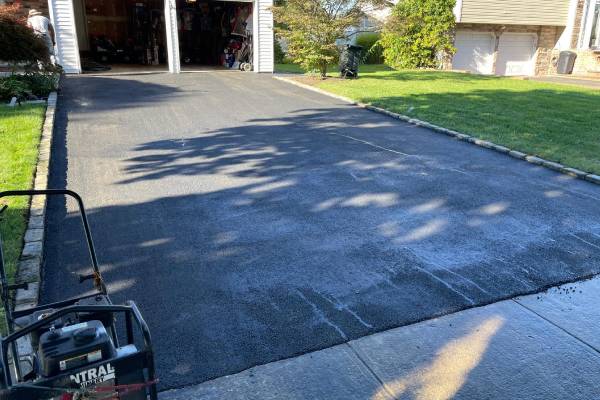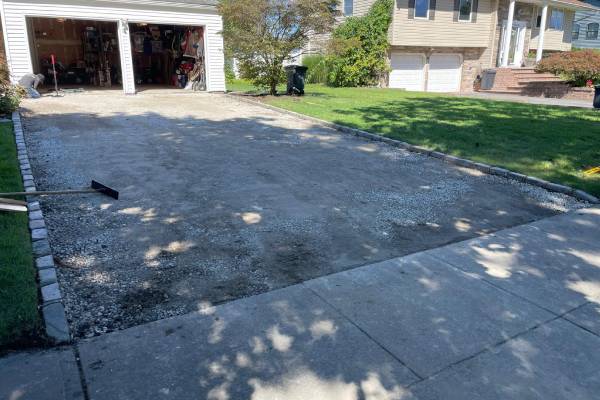Keeping an asphalt driveway or parking lot in top shape is critical for Long Island homeowners and businesses. Harsh weather – from hot sun to freeze-thaw winters – can damage asphalt over time. Ignoring minor wear leads to major repairs, while routine maintenance prevents problems. In fact, Federal Highway research finds that every dollar spent on proactive pavement preservation can halve the cost of future road repairs.
That means simple steps now (like sealcoating and crack filling) protect your investment and save thousands down the line. Islandwide Paving & Masonry, a Long Island paving expert, helps local customers get those savings by catching problems early and keeping driveways looking like new.
What Is Asphalt Maintenance?

Asphalt maintenance is a set of preventive treatments for driveways and parking lots to keep the pavement in “like-new” condition. It includes sealcoating, crack sealing, pothole patching, line restriping, and surface cleaning. Sealcoating (a thin liquid asphalt layer) blocks water, oils, and UV light, preventing oxidation and brittleness.
Crack sealing injects flexible material into cracks to stop moisture from eroding the foundation. Over time, even small cracks allow water infiltration, so sealing them early extends pavement life.
In fact, FHWA notes that routine maintenance applied while pavement is still good can impede deterioration and extend service life in a cost-effective way. One guide emphasizes that preventive care is 6–10 times more cost-effective than letting pavement degrade. In short, asphalt maintenance is all about keeping a good surface good, rather than waiting for major damage to set in.
Asphalt Paving Maintenance Process
A professional maintenance program follows a systematic process:
1. Inspect and Clean
Crews walk the driveway or lot, identifying hairline cracks, surface oxidation, or potholes. Even tiny ¼-inch cracks are noted. The surface is then thoroughly cleaned – debris is swept, plants and dirt removed, and any oil or stain is cleaned off. Proper prep is key to ensuring repairs bond well.
2. Crack Sealing and Patching
Next, technicians fill cracks with hot-pour or cold-mix sealant to prevent water intrusion. Small holes and deteriorated areas are patched with asphalt mix (often cold patch or hot mix). These repairs restore structural integrity before problems spread. Early crack filling can defer larger issues by 2–5 years, and is far cheaper than repairing widened cracks or potholes later.
3. Sealcoating.
Once patched, a fresh coat of asphalt sealer is applied over the cleaned surface. Sealcoating is typically done every 2–3 years. This creates a protective barrier against rain and sun. A sealcoat also renews the deep black color of asphalt, improving curb appeal. Without it, asphalt weathers and oxidizes, losing flexibility. Sealcoating can extend the functional life of pavement by several years.
4. Line Striping (if needed).
If the maintenance involved a parking lot, fresh striping is painted after the sealcoat cures. Crisp new lines and markings not only restore functionality but also boost the professional look of the property.
Each of these steps is far less costly than full resurfacing. For example, a routine sealcoat or crack fill project (often a few hundred dollars) costs only a fraction of an overlay or repave, which can run into the tens of thousands for a large lot.
The High Cost of Ignoring Parking Lot Maintenance

Neglecting asphalt maintenance is a false economy. If small issues are left untreated, the pavement deteriorates and requires major work. By the time the surface is badly cracked or potholed, minor fixes won’t do. You’ll likely face full resurfacing or replacement of a far more expensive project.
For example, replacing a driveway or repaving a parking lot can cost tens of thousands of dollars (far above the cost of routine sealcoating). The image above shows a newly laid asphalt driveway – the kind of result you get after a full repave. That expense could have been delayed or avoided with regular upkeep.
Experts stress that preserving good pavement is the best investment. The National Asphalt Pavement Association (NAPA) notes it’s far more cost-effective to maintain pavement in good condition than to let it deteriorate to the point of “costly and time-consuming rehabilitation”. Similarly, Federal Highway officials point out that prevention (sealing and minor repairs) stops serious damage and keeps budgets manageable.
In practice, each dollar you spend on prevention today can save multiple dollars on repairs later. By contrast, deferred maintenance often means emergency fixes that disrupt business and strain budgets.
Aside from repair bills, ignoring parking lot maintenance brings hidden costs. Rough, cracked surfaces harm vehicles, increase wear-and-tear, and can even raise liability if customers trip and fall. Restoring a neglected lot also takes more downtime. In short, skimping on maintenance can literally cost you money, safety, and customer goodwill.
Why Small Asphalt Issues Become Big Problems?
Small asphalt problems have a way of growing fast. A minor crack might not seem urgent, but it invites water. In Long Island’s climate, water in cracks freezes and expands every winter. This freeze-thaw cycle forces cracks wider and deeper.
As one local contractor notes, “water that enters cracks can freeze and expand, exacerbating existing damage”. Over time, multiple cracks join into larger fissures or alligator (fatigue) cracking.
Once water is under the pavement, the base material washes out. That leads to soft spots and eventually potholes. A single neglected pothole can swallow a tire or cause serious damage. By then, the only fix is cutting out and repaving that section (or worse, the whole drive). That’s a huge leap in cost and disruption compared to the few dollars it costs to seal the crack early.
Heat and oxidation also take their toll. Sunlight gradually dries out the asphalt binder, making the surface brittle and prone to raveling (loose aggregate). A good sealcoat refreshes that waterproof layer and slows oxidation. Without it, oxidation accelerates cracking.
Research bears out this “small to large” progression. Auburn University’s pavement study found that crack sealing extended pavement life by a couple of years when applied early. In well-maintained sections, cracking stayed minimal, whereas untreated sections saw cracks reaching over 20% area after several years. Preventive maintenance like crack seals and chip seals keep the asphalt “stronger, longer”.
In summary, tiny cracks are like ticking time bombs. Deal with them now, and you keep your surface intact for years. Ignore them, and a small fix can turn into a full resurfacing sooner than you think.
How Regular Maintenance Saves Money
Investing in routine asphalt maintenance delivers real savings in the long run. As noted above, keeping a pavement in good shape is dramatically more cost-effective than emergency repairs. Here are some ways maintenance pays off:
1. Extended Pavement Life
Regular sealcoating and crack filling can effectively double the life of asphalt pavement. For a driveway normally lasting 15–20 years, this could mean many extra years before a full replacement is needed. A well-cared-for lot will also hold up to traffic for much longer. Longer life spreads out the cost of installation over more time.
2. Lower Repair Costs
Preventive repairs cost a fraction of major fixes. As a rule of thumb, simple crack sealing or small patches are often one-tenth the cost of repaving that section. Studies show that crack and fog seals add 1–4 years to pavement life, delaying the need for a resurfacing project that might cost ten times more. Essentially, a few hundred dollars now prevents a multi-thousand-dollar overhaul later.
3. Budget Stability
Planning maintenance budgets ahead of time avoids emergency spending. Without maintenance, property owners face unpredictable “repair crises.” With a schedule of sealcoating or patching, costs become predictable. This “proactive” approach even helps local governments and businesses level their budgets year-to-year.
4. Increased Property Value and Curb Appeal
A smooth, clean driveway or lot looks inviting and well-kept. Curb appeal can boost property values, especially in neighborhoods like those on Long Island. In business settings, a fresh blacktop lot suggests professionalism. Maintaining your pavement is an investment in image as well as function.
5. Reduced Liability Risks
Flat, crack-free asphalt reduces trip-and-fall hazards. By staying on top of maintenance, property owners lower the chance of injuries and lawsuits. Over time, avoided liability claims and insurance hikes can also contribute to savings.
Given these benefits, even small actions make a difference. Just as you wouldn’t skip an oil change on a car, routine asphalt care keeps a driveway or parking lot running smoothly. Islandwide Paving & Masonry recommends scheduling a sealcoat every 2–3 years and repairing visible cracks immediately. Our experienced Long Island paving contractors use high-quality materials to ensure each maintenance dollar yields maximum return.
Conclusion
Maintaining your asphalt surfaces is one of the smartest investments a Long Island property owner can make. By addressing minor cracks, sealcoating your driveway, and fixing potholes right away, you prevent expensive damage and extend the life of your pavement.
Government and industry research consistently confirms that pavement preservation saves money: each preventive action saves multiples of its cost.
At Islandwide Paving & Masonry, we draw on years of local experience to help customers protect their asphalt investments. Our full-service team can inspect your pavement, recommend a maintenance schedule, and perform the needed work with minimal disruption. Don’t wait for a small crack to become a budgeting nightmare.
Contact Islandwide Paving & Masonry today for a free quote on asphalt maintenance or driveway paving in Long Island. Regular care now means fewer repairs and more savings later.

